In the realm of interior design and decorating, I daresay one word is probably one of the most polarizing decorating terms.
Chintz.
You know—chintz fabrics; the shiny cotton fabrics depicting bouquets of cabbage roses, largely in pink and green?
At least, that’s how I felt about chintz back in the 80s when I began my interior design studies at the New York School of Interior Design.
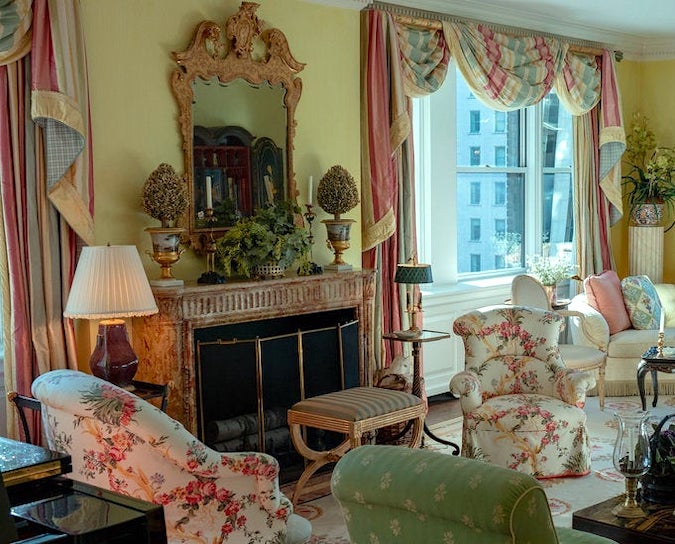
Mario Buatta, AKA “The Prince of Chintz”
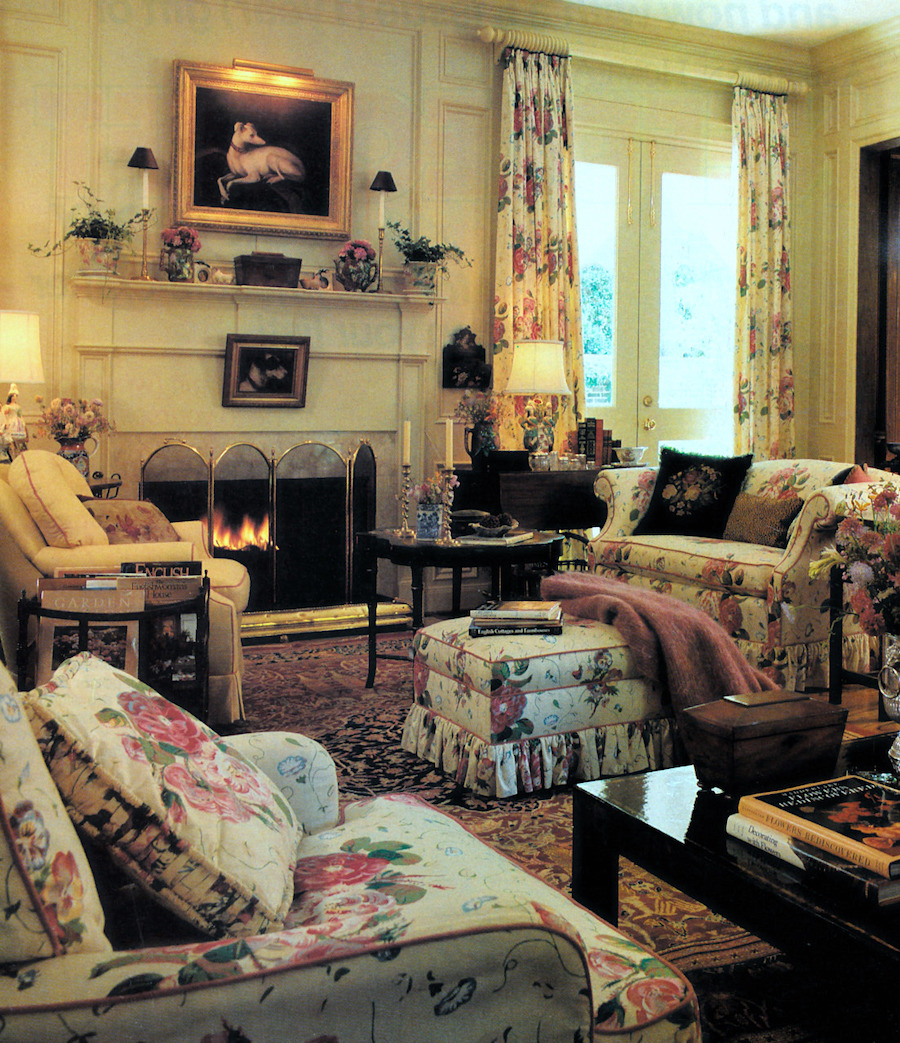
I don’t know who did this room, but judging from the image, it was at least 30 years ago and probably more.
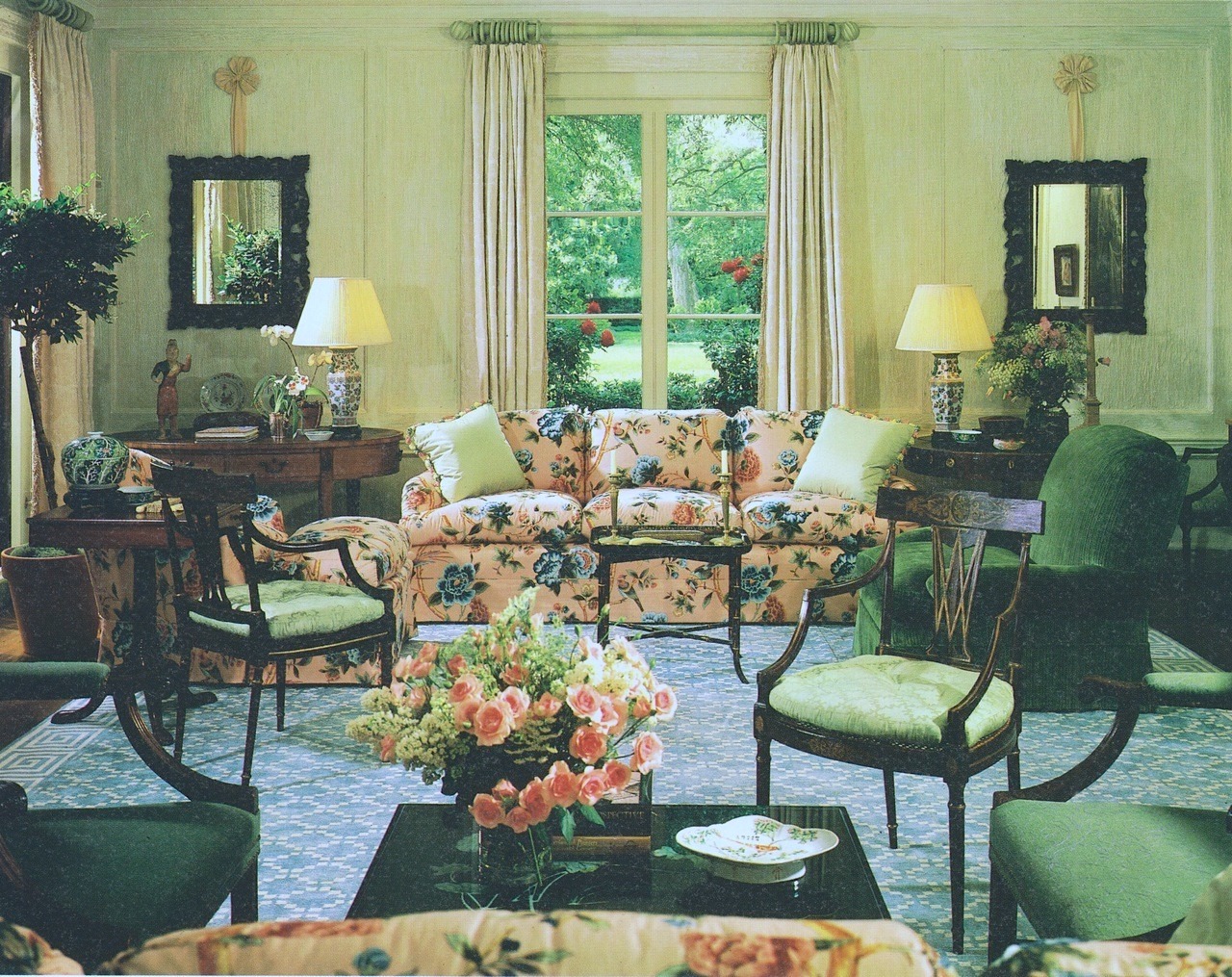
Mark Hampton
Of course, I knew of interior decorating legends Sister Parish, Nancy Lancaster, Mark Hampton, and Mario Buatta.
In my mind, these were are “social register” decorators who created a certain “look” to fit in with other wealthy socialites.
Of course, that’s a sweeping generalization. But, one thing’s for sure. One had to be exceedingly well-heeled to hire one of those designers back in the day.
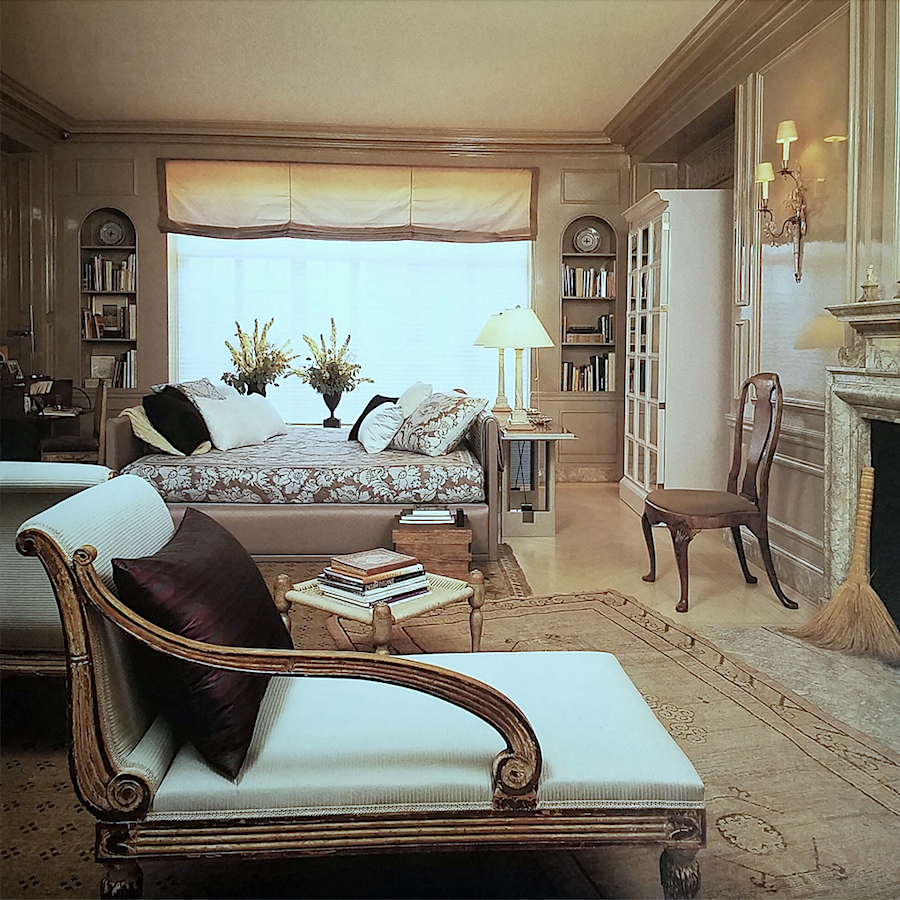
My design idols in those days were Vicente Wolf and John Saladino. Both of them decorated with such a beautiful eclectism and were geniuses with color.
Subtle, monochromatic color, not the sherbet colors of the upper eastside crowd. The two styles couldn’t be more different.
So please hear me out regarding my take on chintz back in the late 80s, early 90s.
I was just beginning to come into my own but still had a LOT to learn. The reality is that I was rarely exposed to this English Country style of decorating. That is until I began working in the field in the early 90s.
To be sure, I embraced everything classical, neo-classical, and post-modern, too. I Loved the work of architects Robert AM Stern and Shope, Reno Wharton, for example.
But, chintz?
These fabrics felt so hopelessly old-fashioned, fussy, and largely lacking in originality. Predictable.

It’s not that there’s anything wrong with this room unless you hate flowers, lol; it just wasn’t my thing.
However, let’s go back to September 1992. Wow, 29 years ago!
Fondly, I recall my first day of work as a decorator’s assistant. I had just dropped off my sobbing-at-the-window-as-he-saw-me-walk-away-toddler at daycare for the first time.
My new boss, Susan, a decorator in Bedford, NY, said in her perky voice. “Laurel, please select three beautiful chintzes to display here. Incidentally, Susan was from Boston. Or, Newton, to be exact.
She pointed to the large-ish round skirted table in the center of her decorating store.
Walking to the cubbies where the fabrics were organized according to color, I was wondering how I was going to do this job.
Three “beautiful chintzes?”
What an oxymoron! I was chuckling to myself, for if Susan knew what I was actually thinking, I’m sure I would’ve been fired on the spot.
However, it was thrilling to have this part-time job three days a week that I dutifully did as I was told. I presented my three selections, and Susan nodded in approval.
Each chintz fabric had a story that she told me with so much love that I was sure I was missing something.
- We did this one for a client…
- I have this one in my home.
- This one has been in Brunschwig’s line forever.
In the coming days, my two-year-old settled into his new routine, and I grew to love my job, especially because it got me out of the house!
The chintz fabrics were still a tough sell for me. But, not all of them.
In fact, the chintz Susan used in the large back window of the store was on a huge pleated Roman Shade with tails. It was also on two custom slipper chairs and two pillows with contrasting cording.
The fabric– Lee Jofa’s Hollyhock in the white and coral colorway.
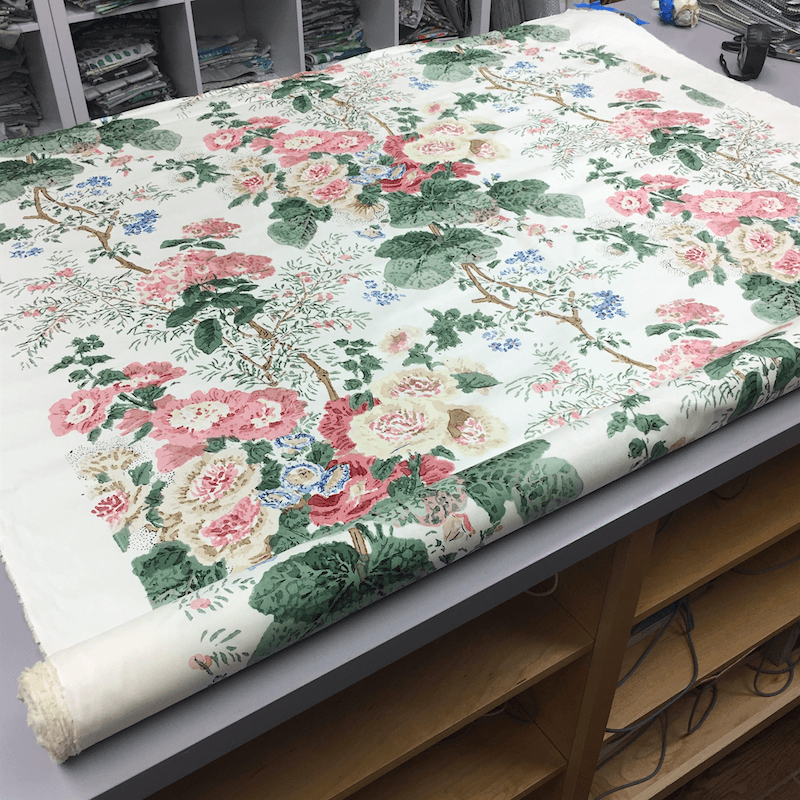
I have to admit that I enjoyed looking at this beautiful pattern which always seemed fresh to me. I noticed that in addition to the pink and green was a beautiful and refreshing blue. In addition, the colors were not as primary as some fabrics. In four years, I never tired of looking at it.
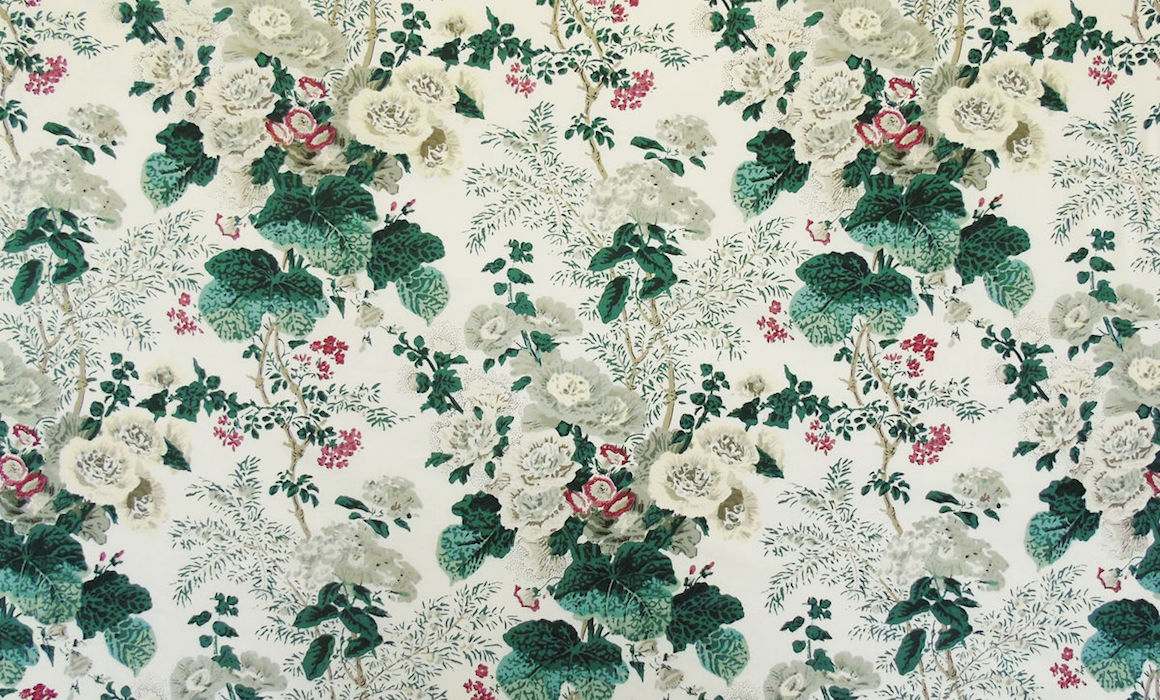
Above is Althea from Lee Jofa, which is a similar pattern, as you can see.
There was a sofa covered in beige chenille fabric.
The walls were painted in an English library green in a ragged finish for texture.
On the floor was wall-to-wall seagrass carpeting.
My desk was actually a small bamboo writing table that was barely big enough and a little too low, but I made do.
My desk chair was a Chippendale-style armchair painted in a glazed faux finish in a similar green to the walls. Then, I first learned what can happen to silk fabric when used for upholstery without a knit backing. (You can see what I’m talking about here with 15 hideous mistakes!)
Oh, Laurel, you had to sit for hours in one of those horribly uncomfortable Chippendale chairs?
Uncomfortable? Are you kidding me? I spent half of my time digging my back into the carved chair back in a sort of a do-it-yourself shiatsu exercise. It was wonderful! lol
In any case, the store where I spent about 18 hours a week felt soothing and elegant to me.
Susan was always fond of saying that this style of design which almost always featured at least one chintz fabric, was always in “good taste.” While I didn’t disagree, I did wish to expand my horizons.
And, yes, there was a formula.
- Of course, a beautiful chintz.
- A check, plaid, or stripe
- Sometimes a jacquard or damask
- Often a chenille or velvet
- And, linen fabrics for the drapes, which were often trimmed with the expensive chintz.
I caught on quickly and began to appreciate this decorating style as it totally suited the gorgeous, horsey town of Bedford, NY, in northern Westchester County, NY.
But, after about a year or so into my nearly four-year tenure there, I saw the movie “Mrs. Doubtfire” set in San Francisco, CA.
Remember, the mom, played by Sally Field, was an interior designer. haha
Near the beginning of the movie, Sally is giving a presentation to a client when out of her mouth came this:
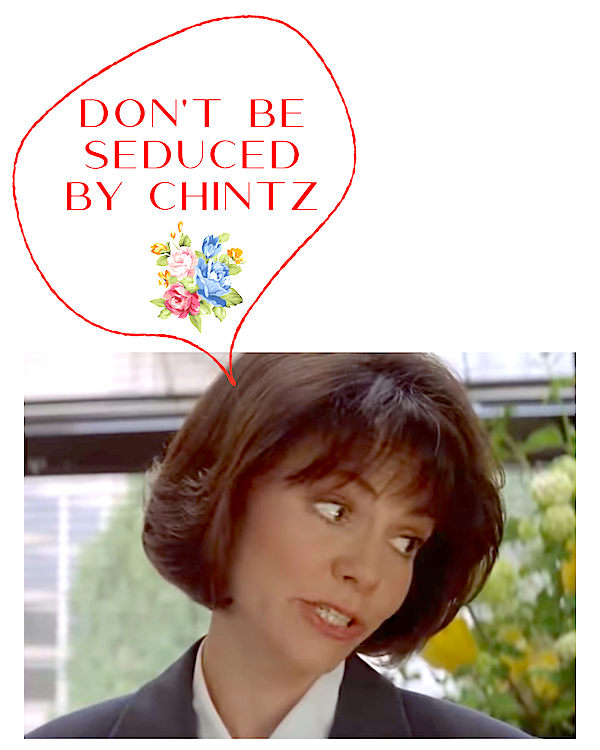
Too late. haha
Over time, I grew to love many of these “tired” old fabrics, and here’s one reason why.
Most of them were bloody expensive. And, most of our clientele didn’t want to shell out some $200.00/yard + (in today’s money) for 80 yards of fabric!
So, these chintz fabrics were used far more sparingly than in some of the iconic designer’s rooms. I mean, we never just plastered the entire room with chintz upon chintz.
That was my first observation. Used as an accent, the floral fabrics were indeed quite beautiful.
Over the years, many of the classic patterns have endured. However, new patterns have been created by designers such as Michael S. Smith, Mark D Sikes, and others.
Now, I’m going to share some of my favorite rooms incorporating chintz and, in some cases, explain why I think these spaces work so well.
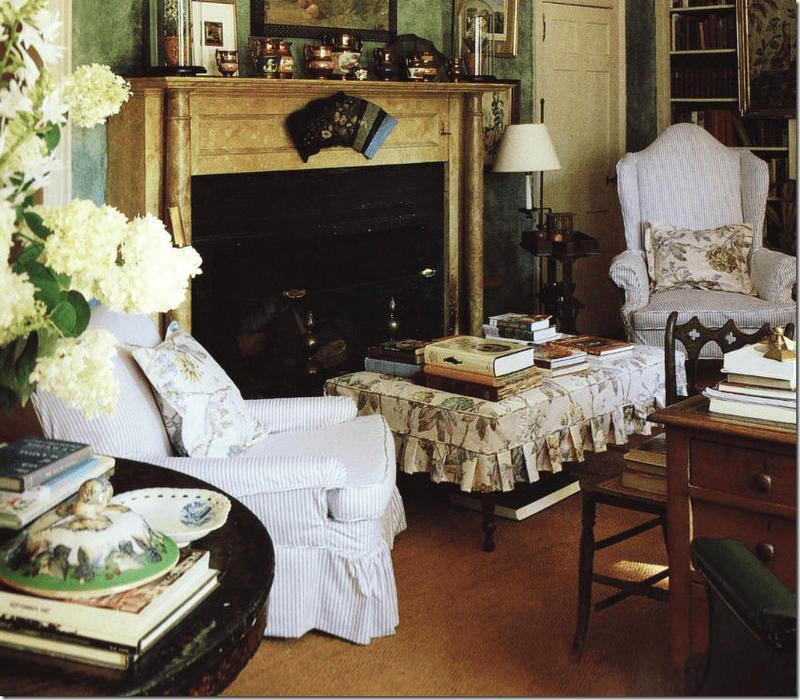
An old image I’ve long admired by Bunny Williams. Classic English country style. I adore the slipcovered chairs and the box pleated detail on the ottoman.
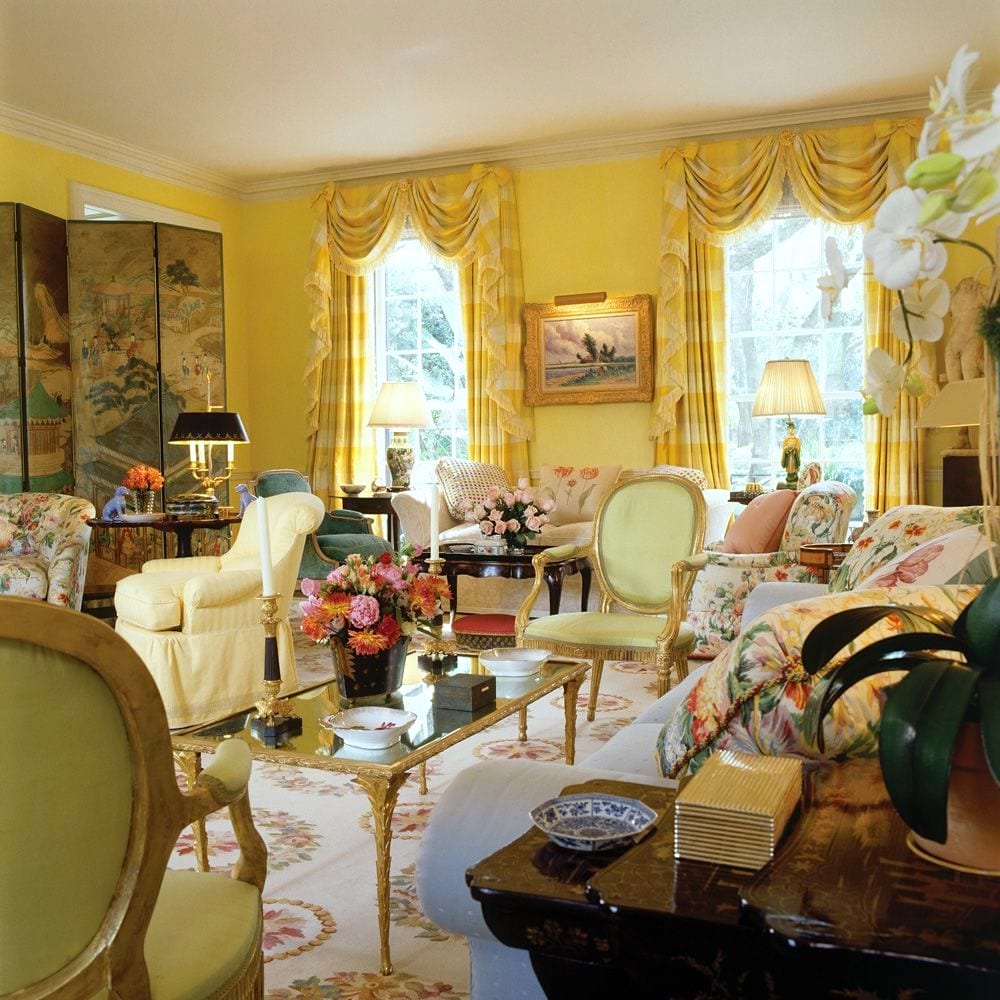
Mario Buatta.
While this look isn’t for everyone, here is where I truly see his genius. His use of color is unrivaled. Also, notice the elements that I’ve concluded are the ingredients of pretty much all great designs.
Black, Gold, White, and Blue

This is such an old photo of Charlotte Moss’s office. And, while I would never do these draperies for myself, I do love them!

One of my favorite images by James T. Farmer.
The print is GP&J Baker’s Nympheus.
You can also find sources on Etsy that make pillows out of this wonderful fabric.
By the way, chintz is traditionally a glazed cotton. But, some of these “chintzes” are unglazed.
And, did you know? If you use a chintz for upholstery, the glaze does wear off over time.

Lady Wakefield home – via House & Garden UK – gorgeous chintz draperies
This is a wonderful example of an updated English Country look. Love this!
One thing I see in these rooms is how refreshing some blue is, even if there is no other blue.
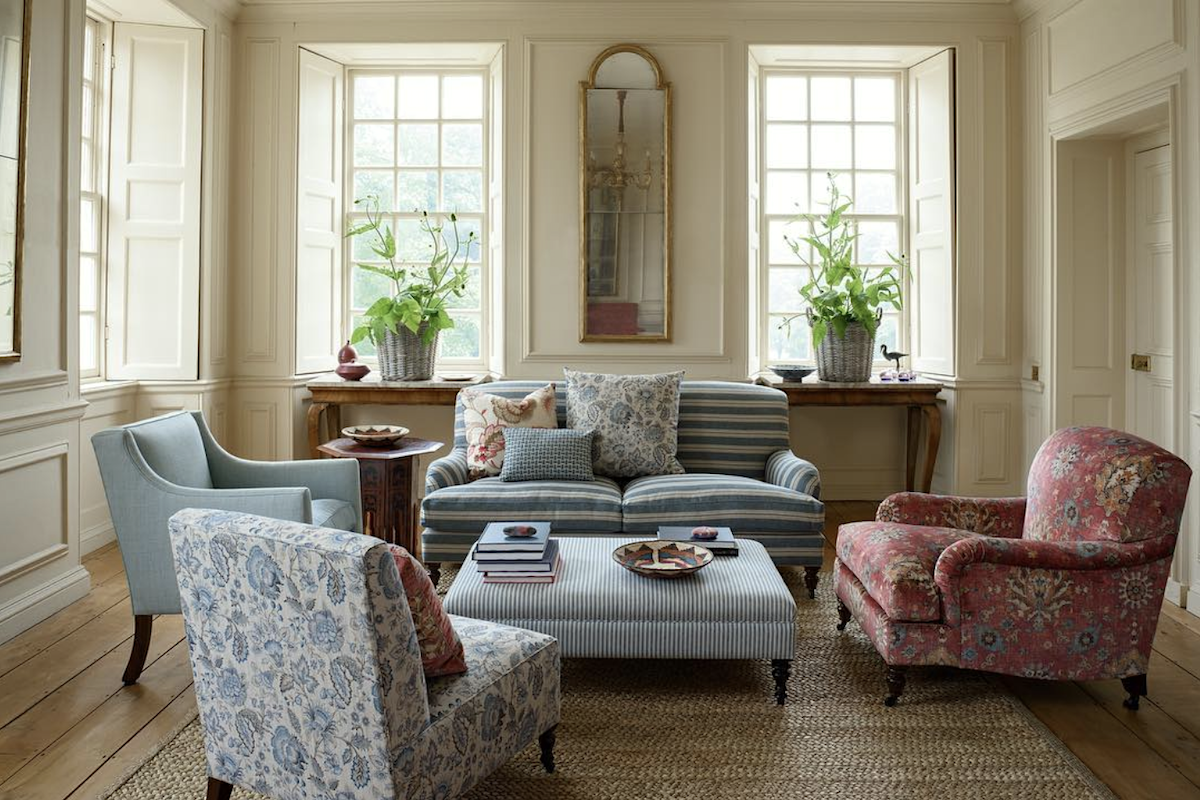
Colefax & Fowler is a venerable company from the UK and also popular in the US. I love this young-trad classical English style. The furnishings are trad but pared down into a look that feels quite breezy to me.
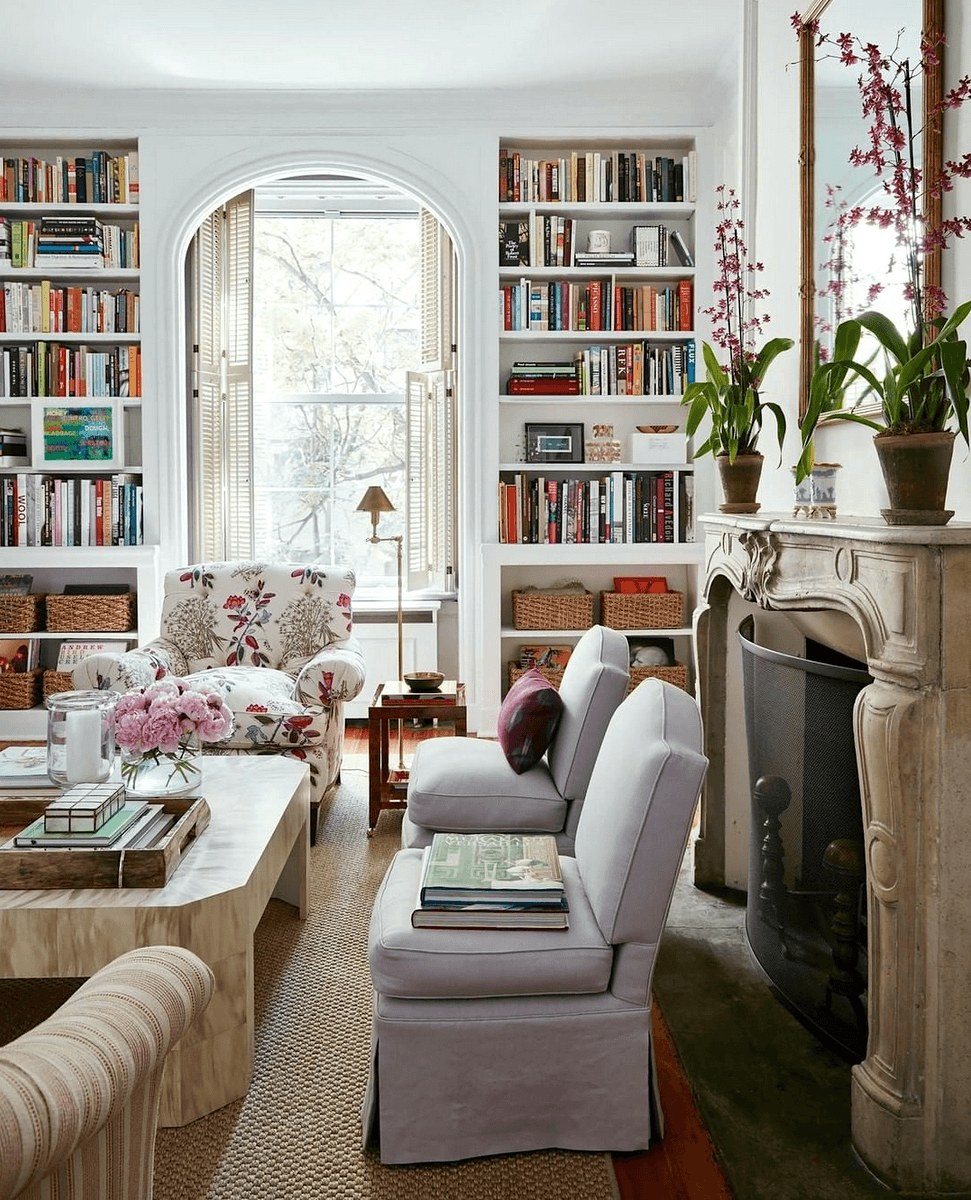
The above chintz is from Quadrille Fabrics. This one is so lovely and French. It’s called. Quadrille Jardins Des Plantes. You’ll find a pillow in one of the mini widgets below.

I’ve long admired this lake house dining/living room by Windsor Smith. And, for years, I tried to find the fabric. Well, yesterday, I finally found it!
I love it when that happens!
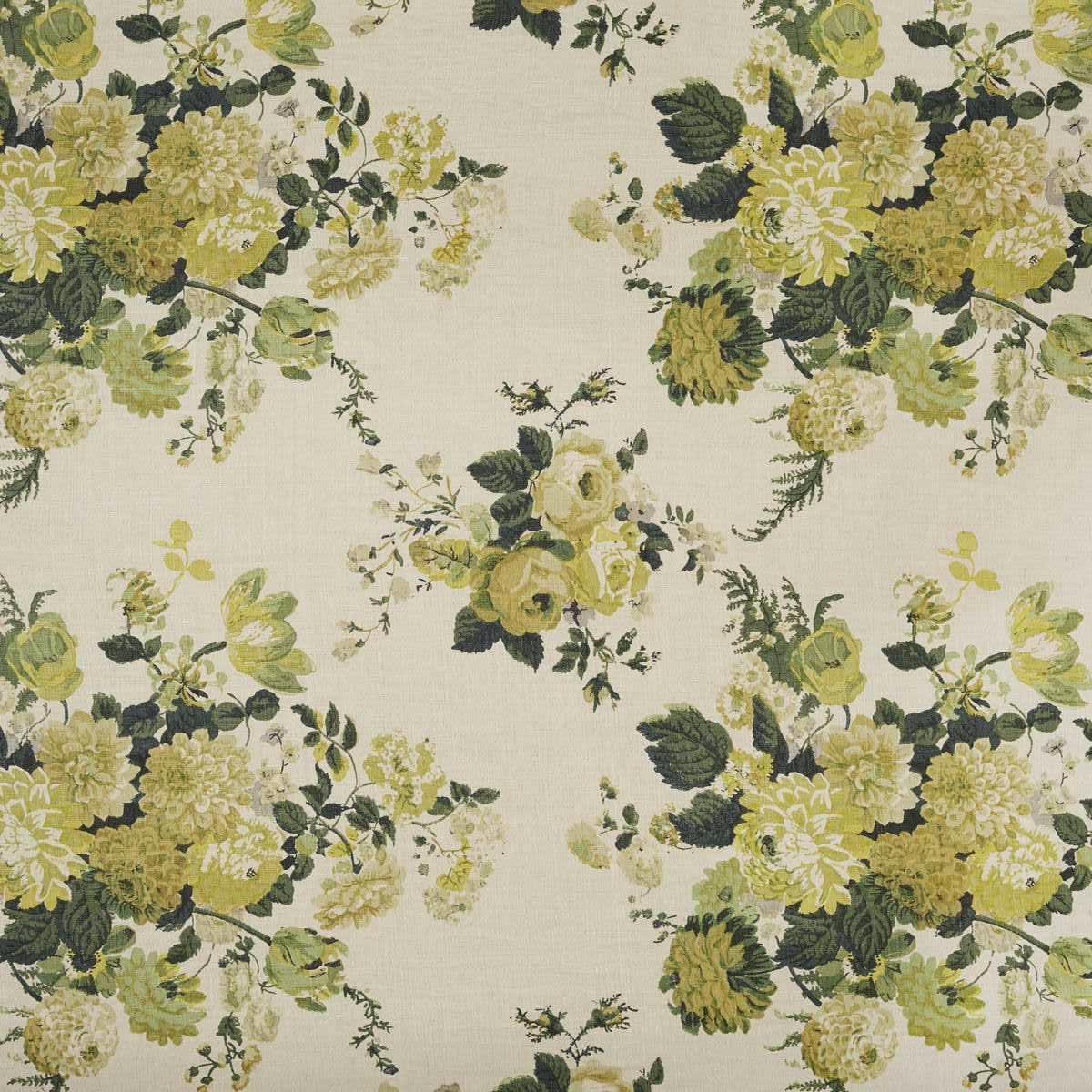
Clarence House – Dahlia Hand Block Green
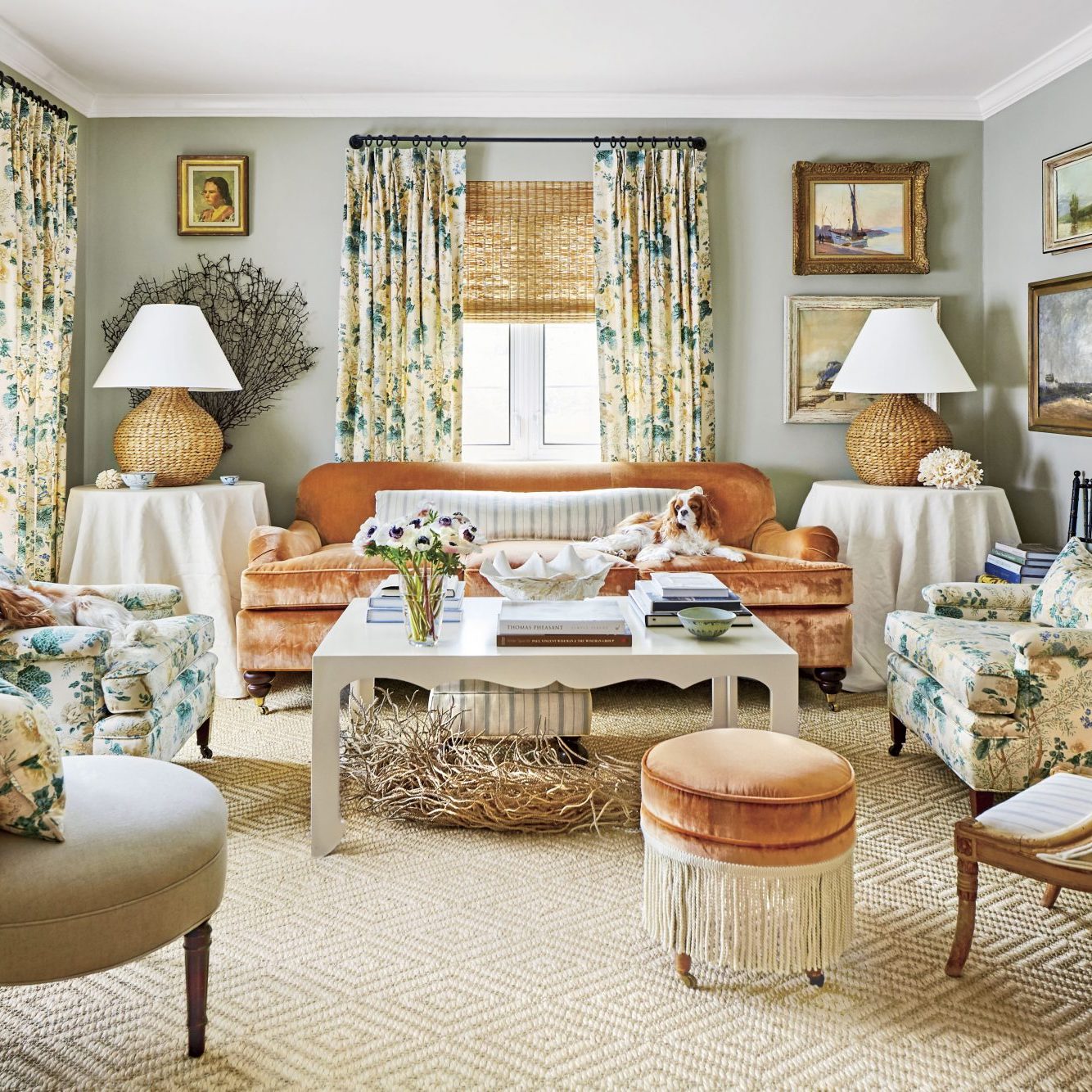
Hanna Seabrook living room via Southern Living – photo – Hector Sanchez
Above is the ubiquitous Althea chintz from Lee Jofa. It is similar in design to Hollyhock. I always get them confused.
 Althea Chintz Citron by Lee Jofa
Althea Chintz Citron by Lee Jofa
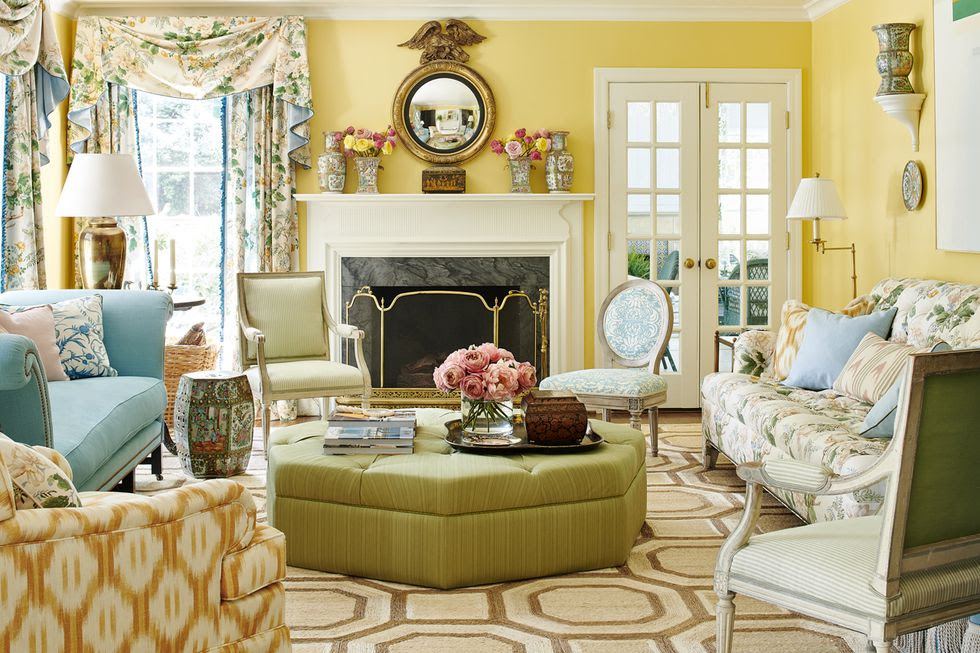
I’m not sure what the chintz is in this wonderful room by Mark D Sikes. But, there’s that blue again! Of course, Mark is known for using a lot of blue in his interiors.
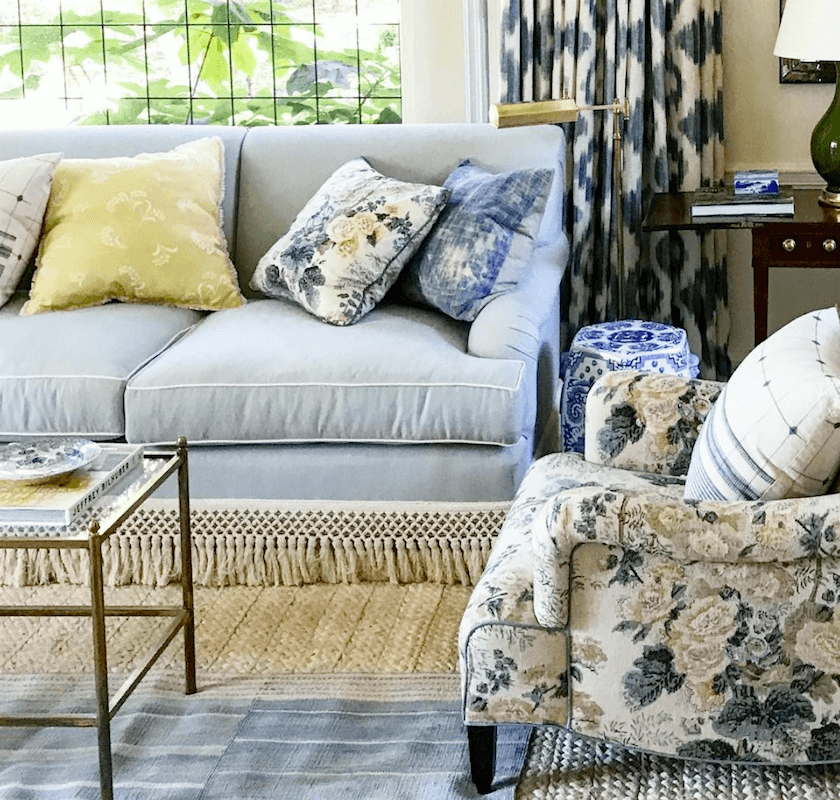
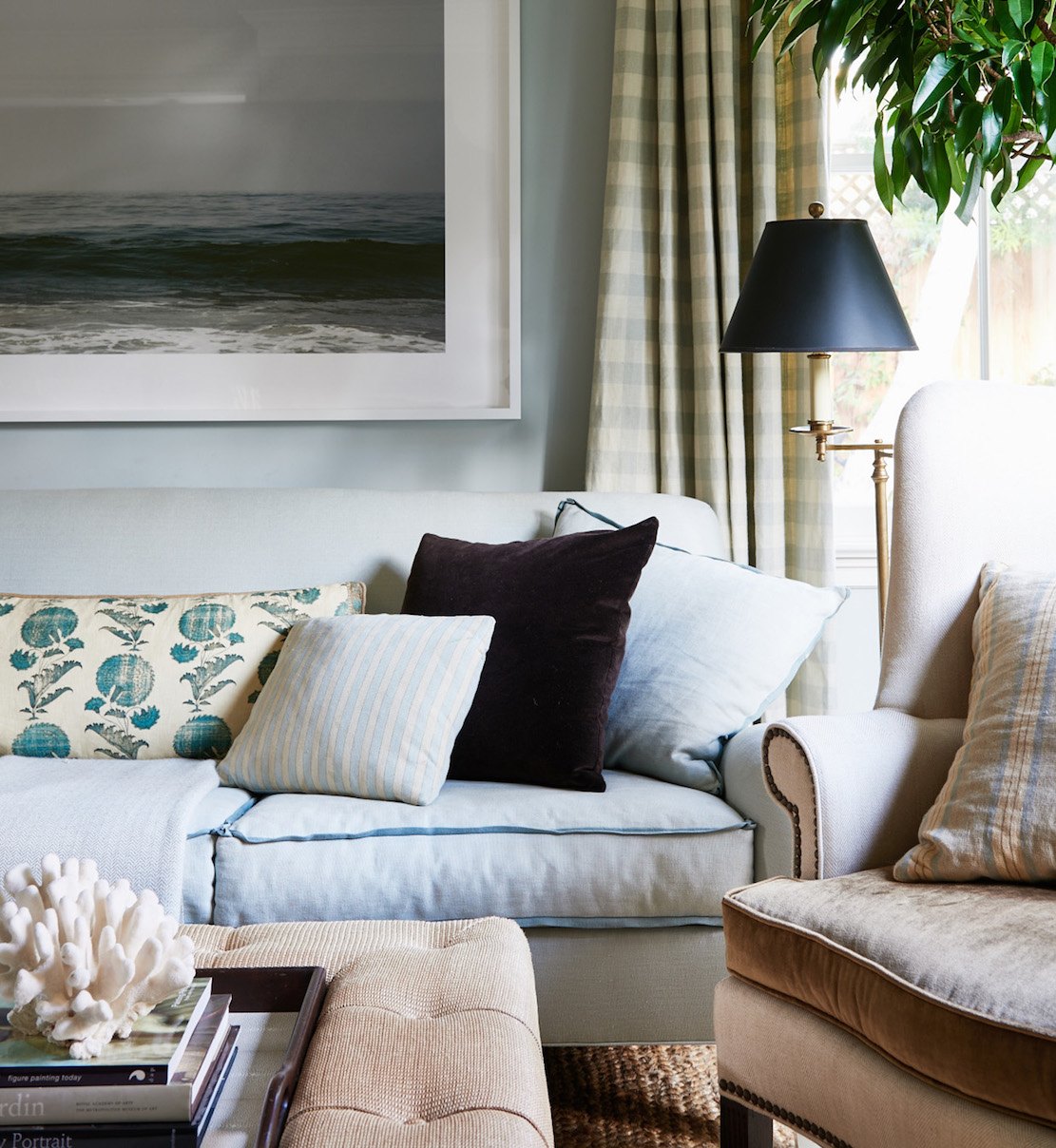
And, I’m finishing off these beautiful rooms that use chintz fabrics with some images of a designer that’s new to me, Caroline Gidiere.
And, boy, is she talented!
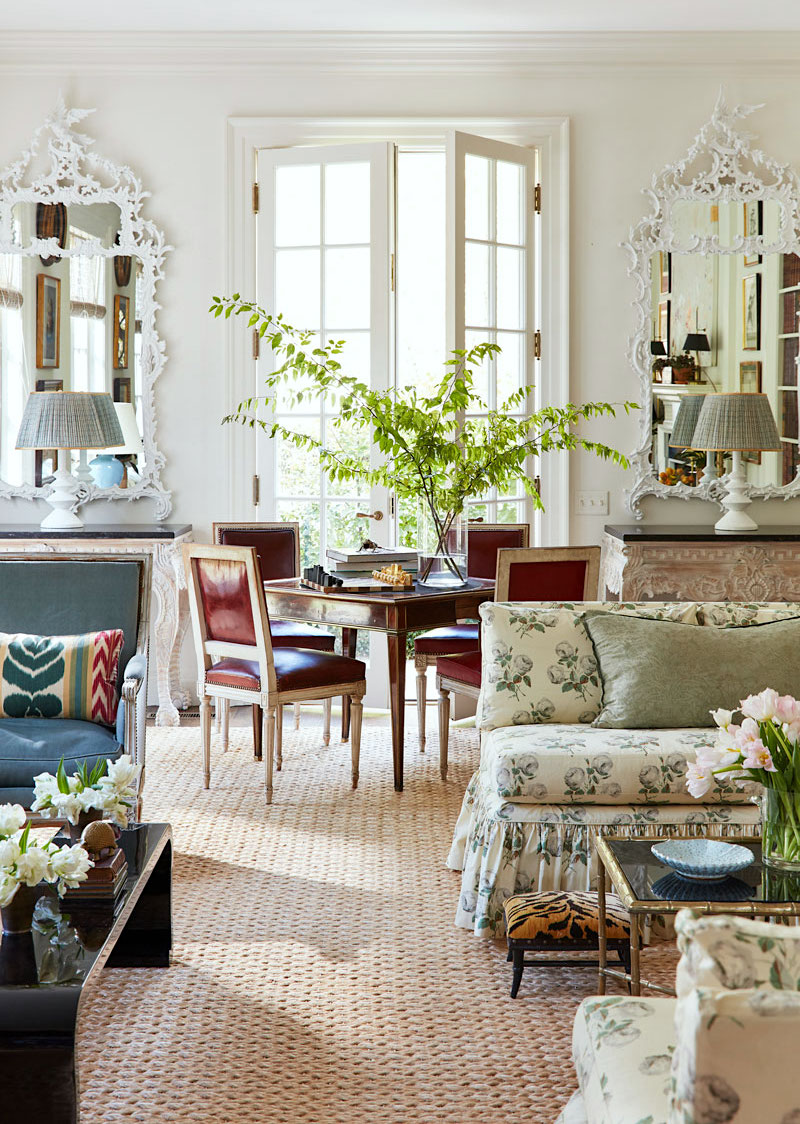
Another iconic pattern from Colefax and Fowler is the Bowood Chintz pictured above.
In fact, it’s become quite popular with Millennials, like the darling blogger Alissa Bovino.

This girl (Caroline Gidiere), knows what she’s doing!
This, to me, is the young-traditional style done to perfection. And one more of the same room, below.
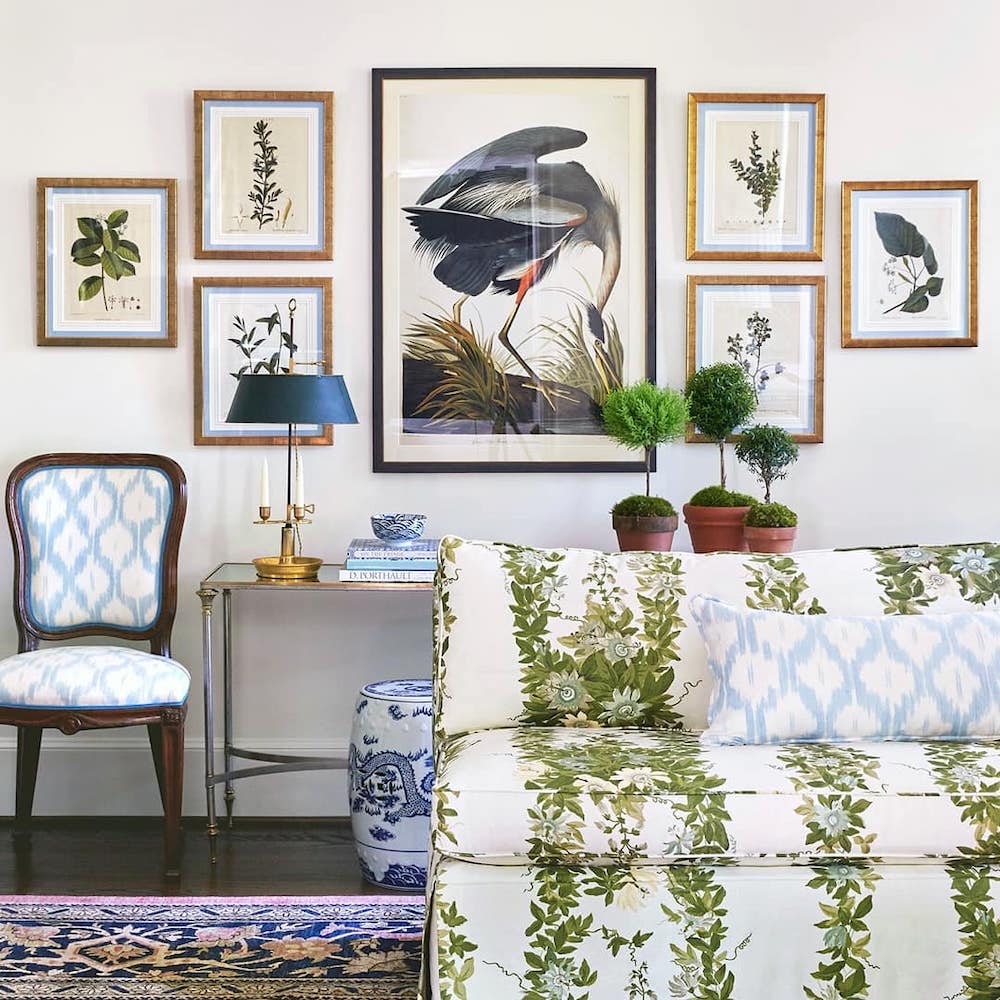 The fabric on the couch is Michael S. Smith’s Malmaison Chintz.
The fabric on the couch is Michael S. Smith’s Malmaison Chintz.
So fresh!
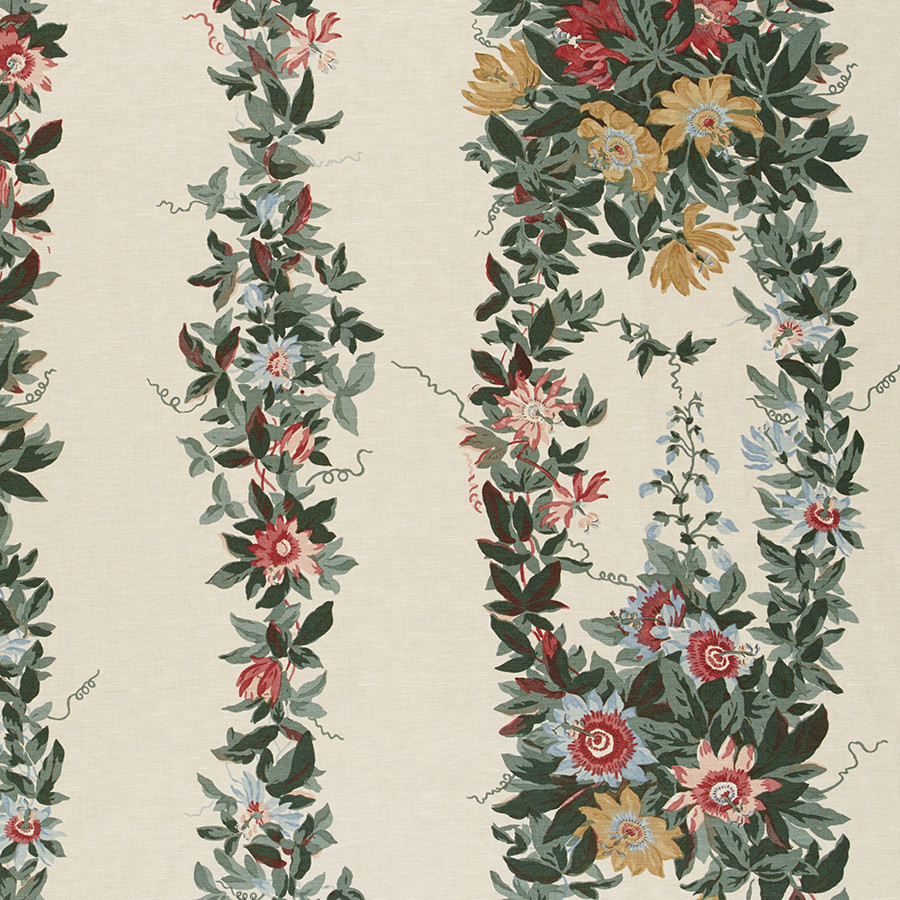
Malmaison in the Jardin colorway.
You may recall that some of the pillows from last week carry these patterns.
And, below are some new pillows and fabrics using many of the fabrics shown in these rooms.


Here are the key take-aways when decorating with chintz
- Less is More. Chintz as an accent is a wonderful addition.
- Play around with the colors, and don’t be afraid to add a color that isn’t there anywhere else.
- Add some blue, black, white, and gold.
In addition, there are a lot more fabrics in this post from last year about dozens of iconic designer fabrics.
And, a follow-up post was one that includes some gorgeous budget fabrics
You also might enjoy this post about the best fabrics for pets and slobs.
Okay, I need to get going to get ready for this storm!
At least my hair is done!
xo,

PS: Please check out the newly updated HOT SALES! There are lots of great sales this weekend!
Related Posts
 The Death Of The Boring White Kitchen and Bathroom at KBIS
The Death Of The Boring White Kitchen and Bathroom at KBIS 21 Best Hidden Storage Ideas, Stairs, Kitchens, Bathrooms
21 Best Hidden Storage Ideas, Stairs, Kitchens, Bathrooms Reconfiguring the Space When What Is There Isn’t Working
Reconfiguring the Space When What Is There Isn’t Working 10 Decorating Questions With Difficult to Find Answers
10 Decorating Questions With Difficult to Find Answers 12 Of The Hottest Kitchen Trends – Awful or Wonderful?
12 Of The Hottest Kitchen Trends – Awful or Wonderful? Gorgeous Family Room Furnishings on a Shoestring Budget
Gorgeous Family Room Furnishings on a Shoestring Budget How To Create The Perfect Summer Home
How To Create The Perfect Summer Home





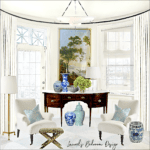
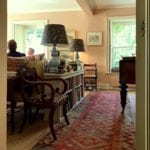





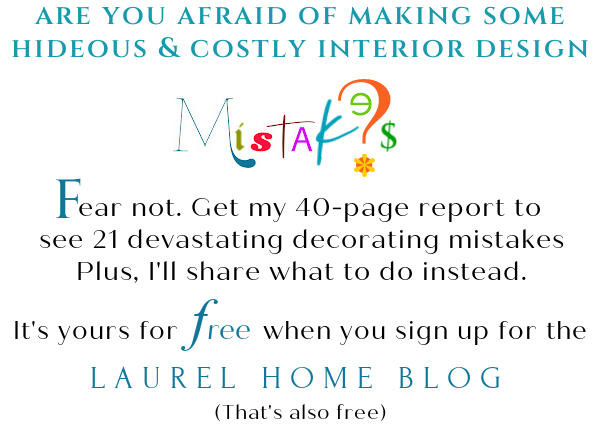
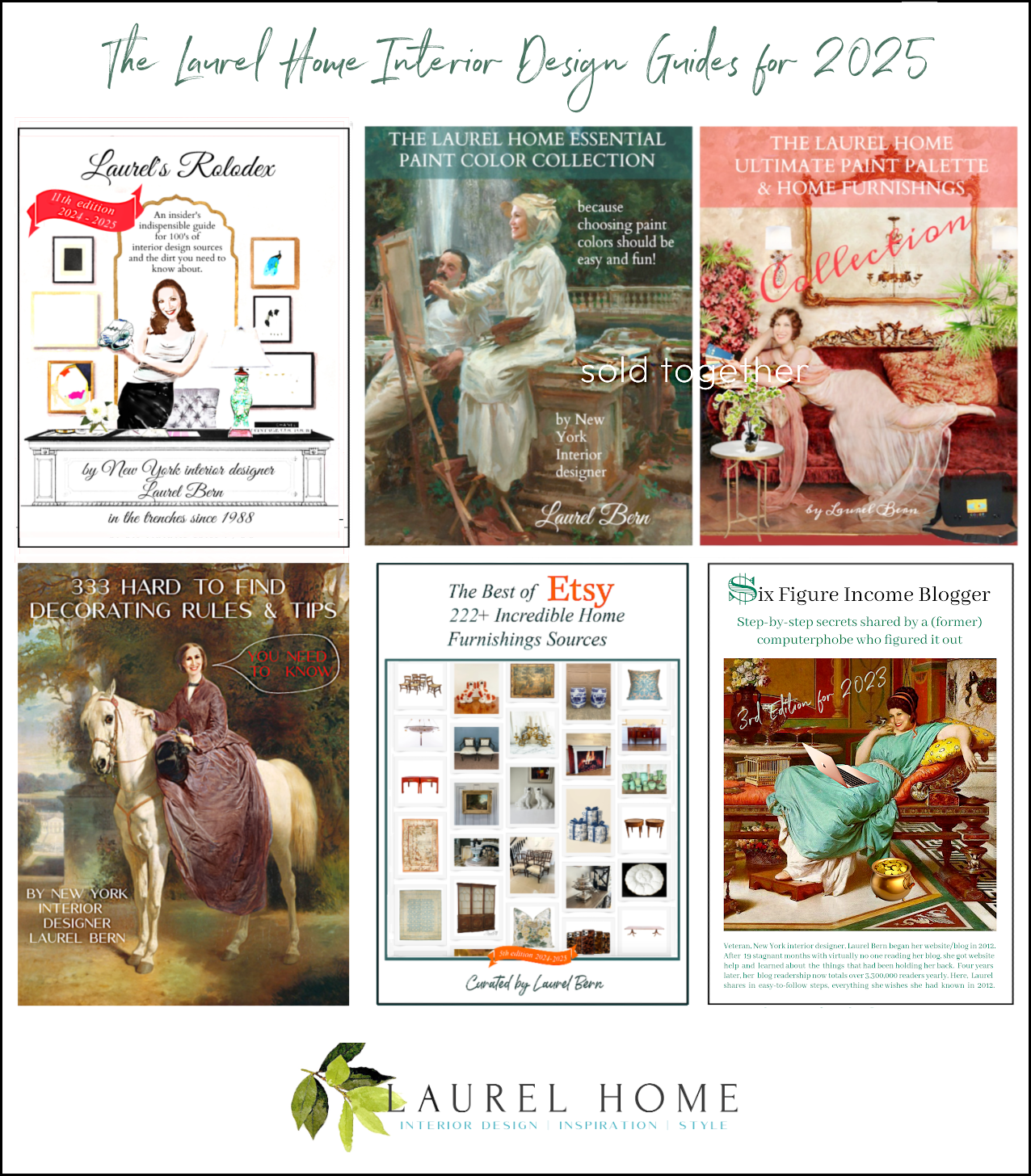

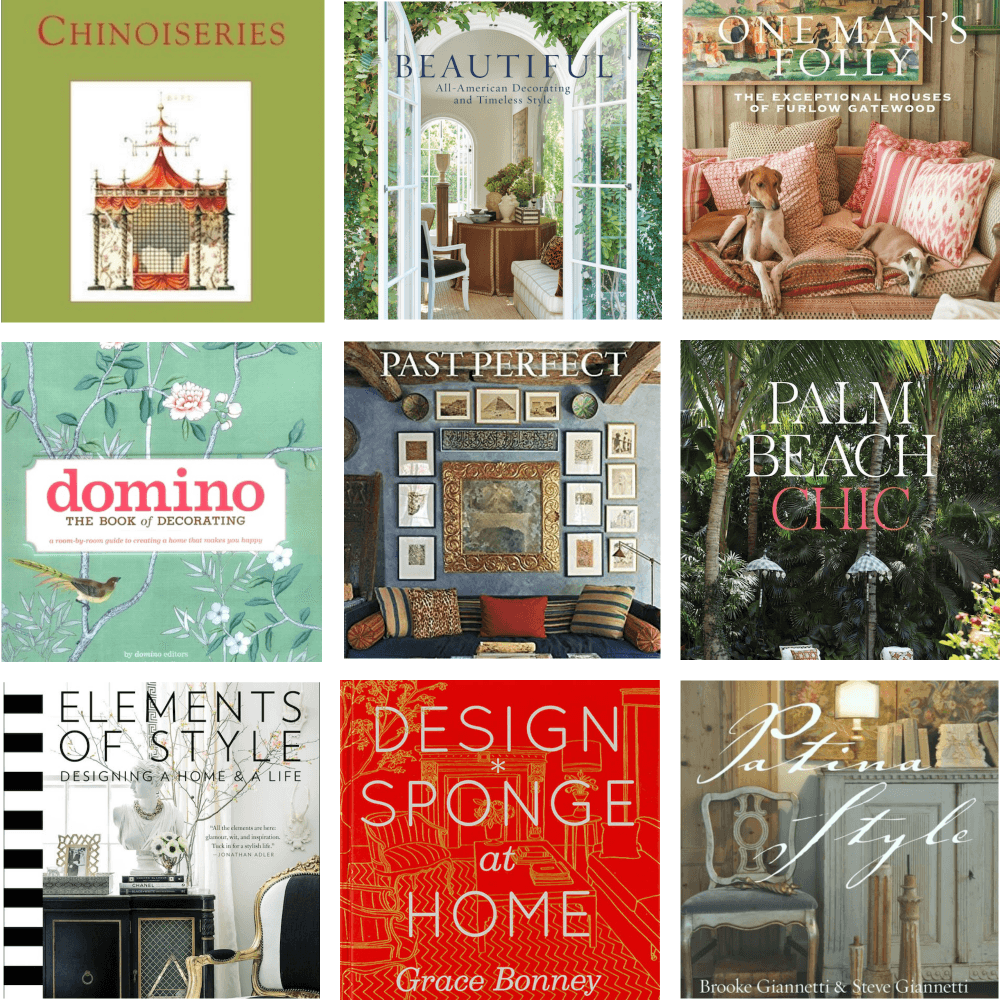

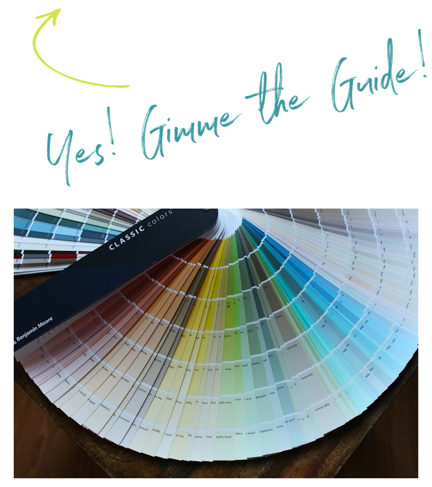
35 Responses
I came for the gorgeous photos that showed up on pinterest, saw the subject line of this post and was like, “whatever, I love chintz. I’m just here for the stunning photos.” But I stayed for your post and I’m so glad you can look back on the chintz trend as fondly as I do! Everything chintz is of course overwhelming, but it is absolutely essential to a tasteful country cottage aesthetic which is back in full force. Thank you for the lovely post and the beautiful inspiration pictures.
While generally not a chintz fan, you did open my eyes to a couple I could imagine using in my design work. Thanks, lovey!
LAUREL! Thanks for another fun read. I’m 51, and since I was little, Chintz in a room, esp furniture was just an old money marker. “Oh that
Old thing? Haha. We probably should have Roger redo it. But it just won’t wear out!”
Etc.
I love it. I’m SICK and TiRED of the current looks everywhere. Modern Blah. Beige/grey/greige on EVERYTHING. I got sucked in six years ago- walls, floors, furniture – and it looks very magazine-y but It’s so DULL. So I say cheers to chintz and for having a pair and committing to fun and color. I just got a huge violently-colorful rug in blue, green, orange teal And I love it and have started to go nuts adding color back in. We have pretty intensely landscaped backyard so it was a real shock to go From blooming pergolas right to our door to an old black and white movie inside. Chinz does that. i am currently googling “Clarence House – Dahlia Hand Block G” Bc I think I need some of that cheer in this house! Thanks as always!
The one room of chintz I found appealing was that of Caroline Gidiere, probably because it’s a limited color palette and tone on tone. I like the ikat much more than the chintz. I find too much movement and pattern to be visual clutter and tiring. Less is truly more in my view.
I like many of the floral patterns but not the smooth, shiny chintz material itself. I think some of these classic prints may be available on linen, which has the weight and texture I prefer.
Chintz is not only cool, but very chic!
I think the bad rap it got isn’t so much from the fabric prints themselves but the overall style in which they were used in the 80’s. Most people were introduced to them by a poor man’s version of English Country and the real identifying piece in these interiors was the chintz that unfortunately took all the abuse.
These interiors where characterized by the puffy Croscill gathered valances that were stuffed with tissue paper installed on white expansion rods over mini blinds, silk flower arrangements and floral wall paper borders that coordinated with the fabric. The slip covers had really gathered ruffles or multi colored bullion fringe sitting right along side a velour La-Z-Boy recliner and wall to wall carpet in one of those goldish mid-tone browns. It was awful and also extremely feminine. These rooms didn’t have any edge or classic pieces of furniture in them.
I love chintz and a big bonus is that it looks great with the Scalamandre Leopardo and Tiger velvets which I’m always looking for an excuse to use.
Dear Lauren, thank you for another great article. Since you’re a fan of some things Russian, you may be interested to learn about a great textile tradition of Russian chintzes spanning 1860s through mid-eighties of the last century. These fabrics were produced to serve the Central Asian markets and therefore embraced vivid, bright colors in the “more is more” philosophy. No pastels there – bright Turkey red, yellow, orange and dark blue cabbage roses! A bit psychedelic even. They also borrowed from the Indian and Central Asian esthetic by incorporating floral forms (lotus, paisley) found in these traditions.
First, the mystery fabric you asked about in your email is Bennison’s Wheat Flower. It’s a favorite!
http://www.bennisonfabrics.com/wheat-flower-green-blue-brown-on-oyster
Second, I am obsessed with chintz patterns (and similar), evidenced by all the large florals in my pillow shop. Thanks so much for linking to several in your widget! I love them both in small doses, or covering a room from top to bottom.
Hi Laurel,
Lovely to see chintz again. I don’t think it’s passé at all.
It wasn’t as popular for awhile, but currently, especially with southern grand millennials it’s all new again.
Many of those patterns that Laurel showed are as popular as ever.
Thank you Laurel
Excellent post, but i’m chintzy, so it’s even better. Stay dry in the storm!!
I want a sofa in that fresh, French blue! Florals don’t seem to suit me though. Alisa just redid her bedroom around Bowood, it’s seriously gorgeous. Happy to see her get a shoutout here!
Great post Laurel! I love Chintz. My grandmother had it in her home and she had a gorgeous chaise lounge covered with it in her bedroom. I coveted it!
But I agree with you. Either you’re a designer that knows how to use Chintz perfectly like Bunny Williams, or you use it sparingly.
And I adore Alisa Bovino and her style!!! She created gorgeous classical rooms but with a fresh updated look. Love her work!
Fun to see all these pretty patterns. And I’m not a floral fabric person, but I do love a beautiful Chintz!
I’ve loved chintz since I was a little girl which was a complete 180 from my mother’s design taste which leaned towards anything “Oriental”. But, even though I am 57 and embrace less fuss, I absolutely would still use a beautiful chintz in a room. I also inherited a few lovely pieces my mother had and I treasure them now…. Everything in moderation. Stay safe, Laurel! Loved your post as always!!
You and I entered the design workforce about the same time – late 80s. My first full time design position was with Kenneth Alpert. They used so much pattern in every room. Pattern on pattern. I spent at least 6 hours every single day for over a year at the D&D. I know where every chintz was hanging. It was dizzying. Then I went from KA to Vicente Wolf who never used a pattern on anything. Ah, the calm was a gentle wave over me. I was much happier!
I love chintz, pink, green and blue with the big fat cabbage roses. Toile de jouy, and seer sucker stripes. It is southern and cozy to me. I’m so glad to live with what I like and not worry if I am out of style!! I love your posts and find them hilarious with your side remarks. Love this new to me designer Caroline Gidiere!! I agree also on the designer Mark D Sikes and his use of blue as I have to admit I have it in every room in our condo! Thank you for always letting us express ourselves! You’re the Best!!!!
Chintz is still a hard sell for me, but that John Saladino room is so fabulous. I just love his style, and it is so timeless.
Child of the 80s/90s here… just want to say I love the movie Mrs. Doubtfire and know that scene with the chintz!
Thank you Laurel for showing us the beauty of chintz.
Maybe you get confused between the two fabrics because Althaea and Hollyhock are actually the same plants in nature.
These fabrics and plants are so romantic!
I love Allisa’s blog, https://aglassofbovino.com/ and have used it heavily in decorating on a budget. But I don’t believe the last two pictures of living rooms are her work in the way you seem to be attributing them to her. Perhaps I’m reading it wrong?
Hi Cris, Sorry for any misunderstanding. Those rooms are all the work of the designer, Caroline Gidiere.
I agree with Susie, “Some of those rooms would be perfectly acceptable if you eliminated the drapery treatments and bed canopies.” And I’ll add: eliminate matching wallpaper. I LOVE chintz and green and pink, too. I hate that chintz is passé. And unfortunately, it seems that home decorating has gone too far in the other direction now with way too much neutral that leaves colorless and bland/blah rooms.
I’ve learned so much from you about analyzing rooms, and this post proves it. As I carefully looked at each room featuring chintz, even though they were 30 ish years old, I saw good design which means I could appreciate the timelessness of talented designers even with chintz as the topic.
Also Blue, black, white and gold are my new checklist.
Glad I found you even though I have a very long way to go I’m deeply interested.
So glad your hair is done! Growing up in Palm Beach the standard hurricane prep was my father would go off to the liquor store and my mother would go to the hairdressers! Stay safe.
Thanks for the formula. I like some flower print, but the rest I had sort of figured out on my own, but it’s good to see valldation.
Hi Laurel,
I hope you’re safe & have power. Henri could cause a lot of damage.
I just looked around my home & I don’t have a single floral pattern in it. I think it’s because I tire of them quickly. I also prefer a more masculine space.
But I remember back in the late 80’s & 90’s loving them.
Stay safe.
Laurel, I went to Newport, Rhode Island last week and toured the Gilded Age homes that were open (some are closed due to staffing issues…they can’t find people to work). Have you ever been? I think this subject would make an interesting post for your readers and isn’t far from where you live now. Doris Duke has her home on tour as well as “The Breakers” which is a Vanderbilt home, “The Elms” was my favorite. It was all amazing and what a cute place to visit.
I feel like some of the cheerful trends of the ’80s and ’90s get a bad rap. I realize it’s not everyone’s cup of chai, but I loved coming home to bright, colorful fabrics and wallpapers. I also loved some of the DIY sewing and crafts that the period lent itself to. Of course, tastes have changed; I’m in my animal print and Chinoiserie phase now. I suppose people will look back on 2021 in horror, too.
Lovely post Laurel! How about a post on wallpapers for dining rooms and/or powder rooms? I don’t recall you doing that. I’m trying to bring some life into a dark dining room and I don’t want to embrace the dark!
I’ve loved chintz I first saw it in my Aunts workroom. She saved pieces she loved from clients. I instantly loved the shiny waxy surface – do they even make it like that anymore?
The Hollyhock and Althe I am familiar with, are a soft linen feel – very different from original chintz.
I love REAL English Chintz! Bennison Fabrics have the most beautiful in the world. Robert Kime does wonderful ones in soft colours and subtle designs. Soane has some terrific designs too. But I always go back to Bennison which are based on 18th century fabric swatches from great country houses. Poison pink and green are not to be found at Bennison, Soane or Kime. Check them out – a post I think Laurel!
I reupholstered a soa in a beautiful chintz in the mid 90’s. For years during the 2000’s when it was so out of style, I begged guests to spill red wine on it so I’d have an excuse to get rid of it. Now it’s back in style and I’ve done the whole room around it – and though it’s in a sunroom it hasn’t faded a bit. My chintz sofa will probably be sat upon during my wake!
Mario Buatta…..quite the celebrity circa 1980s! I once attended a luncheon where he was the guest speaker. A woman had asked, “Mario, how do I get that English look?” His classic remark: “Buy a $20,000 sofa and throw dog hair all over it.”
Underneath my white cottage slipcovers is a chintz that will last 100 years!! Ha! They wear like iron, are always soft, never show ANY soiling and make it hard to move on when you just grow tired of the pattern. After all, they are in such great shape, so it’s hard to justify something new!! The good news and bad news about chintz!!
Some of those rooms would be perfectly acceptable if you eliminated the drapery treatments and bed canopies. The James T. Farmer photo reminds me of what I currently have going on in my condo living room area-same sorts of colors, etc.
Not to start this off on the wrong foot, but I love plain chintz and tone on tone chintz. Cabbage roses, not so much. Chintz has a wonderful feel, cool and crisp.
Stay safe.